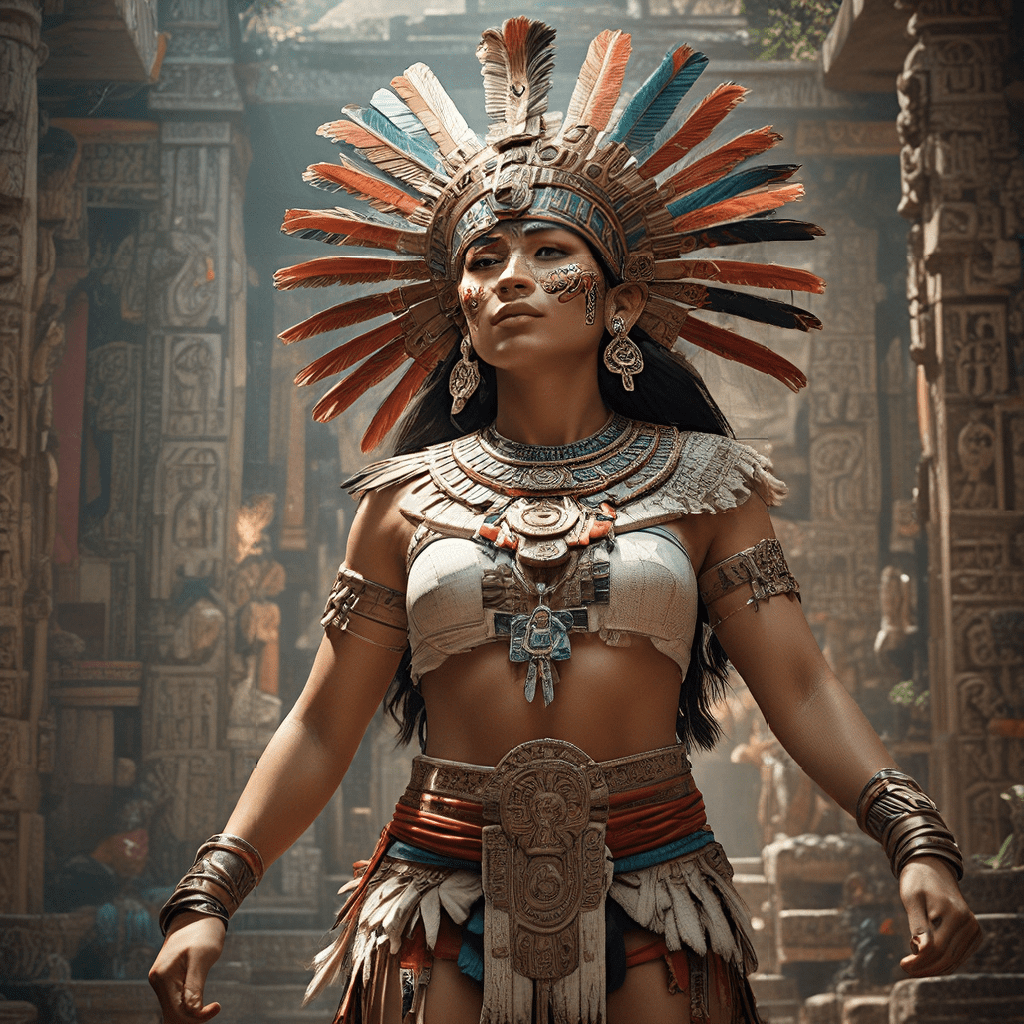The Earth Mother: Tlaltecuhtli in Aztec Mythology
In the rich tapestry of Aztec mythology, Tlaltecuhtli stands as a formidable and enigmatic figure, embodying the very essence of the earth itself. This powerful deity, also known as "Earth-Eater," is often depicted as a monstrous being, symbolizing the primal forces of creation and destruction. Tlaltecuhtli is not merely a passive earth goddess but a dynamic force, a mother goddess who nurtures life but also devours souls in a constant cycle of existence. As one of the most important goddesses in the Aztec pantheon, Tlaltecuhtli played a crucial role in shaping their worldview, influencing their rituals, and shaping their understanding of the world around them.
Tlaltecuhtli: A Powerful and Formidable Deity
Tlaltecuhtli, whose name translates to "Earth-Eater," is a complex and powerful deity in Aztec mythology. She is often depicted as a monstrous being, with gaping jaws, sharp teeth, and claws, symbolizing the earth’s ability to both nurture and consume. Although she is sometimes described as a female deity, Tlaltecuhtli is also genderless, representing the raw and primal forces of the earth. Her power is so immense that she is said to be able to shake the earth and cause earthquakes, reflecting the unpredictable nature of the natural world. Tlaltecuhtli's presence is felt throughout the cosmos, reminding the Aztecs that the earth is both a source of life and a reminder of their own mortality.
The Creation Myth: Tlaltecuhtli’s Sacrifice and the Birth of the World
Tlaltecuhtli's role in the creation myth is central to Aztec cosmology. The myth tells the story of how the gods, led by Quetzalcoatl, sacrificed Tlaltecuhtli, her body being used to form the earth. They ripped her limbs apart to create the heavens, mountains, and valleys. The Aztec creation myth emphasizes the intimate connection between the gods and the earth, highlighting the importance of sacrifice and the cyclical nature of life and death. Tlaltecuhtli's sacrifice also emphasizes the importance of honoring the earth and its resources, which are essential for human survival. This creation myth shaped the Aztecs' relationship with the earth, influencing their agricultural practices and their understanding of the sacredness of the natural world.
Tlaltecuhtli: The Earth and Its Depths
Tlaltecuhtli embodies not just the surface of the earth but also its depths. She is the goddess of the underworld, Mictlan, where souls journey after death. As the earth's creator, she is also its guardian, with the power to control its resources, including water, plants, and minerals. She is associated with the elements, especially the earth and water, and her domain includes the fertility of the land, the growth of crops, and even the movement of tectonic plates. Tlaltecuhtli's role in the earth's depths connects her with the underworld and the cycle of life and death.
Tlaltecuhtli’s Role in Fertility and Agriculture
As the earth goddess, Tlaltecuhtli plays a vital role in fertility and agriculture. Her power is invoked by farmers to ensure bountiful harvests and to protect crops from disease and pests. The Aztecs believed that Tlaltecuhtli could influence the growth of crops by controlling the amount of rain and the fertility of the soil. To honor her, they offered sacrifices of food and blood, and they often invoked her name during agricultural ceremonies. Tlaltecuhtli's association with fertility also extended to human reproduction, and she was sometimes invoked for blessings and protection during pregnancy and childbirth.
Tlaltecuhtli as a Devourer of Souls
Tlaltecuhtli, the Earth Mother, wasn't just a nurturing force. She was also a powerful figure associated with death and the underworld. In Aztec beliefs, souls journeyed to Mictlan, the underworld, after death. Tlaltecuhtli, as the ruler of Mictlan, was believed to devour souls, symbolizing the cyclical nature of life and death. This duality, where she both gives life and takes it, is a central theme in her character. The Aztecs understood that death was not an end but a transition, and Tlaltecuhtli embodied this cycle with her role as both creator and destroyer. Her hunger for souls was seen as a natural part of the earth's process, reminding the Aztecs of their mortality and the need to live a life worthy of respect.
The Depiction of Tlaltecuhtli: Monster or Mother?
Tlaltecuhtli's appearance often reflects her dual nature. She's frequently depicted as a monstrous creature with gaping jaws, sharp teeth, and claws. This imagery emphasizes her power and the earth's ability to consume. However, other depictions portray her as a more nurturing figure, with a motherly aspect. She is often associated with the earth's fertility, its ability to give life and sustain. This duality is reflected in her name "Earth-Eater," which highlights her role in both creation and destruction. Her depictions, whether as a ferocious monster or a nurturing mother, serve as powerful reminders of the earth's endless cycle of life and death.
The Influence of Tlaltecuhtli on Aztec Culture and Ritual
Tlaltecuhtli's presence is felt throughout Aztec culture. Her importance is reflected in their rituals, which included sacrifices, offerings, and ceremonies designed to honor her. The Aztecs believed that maintaining a good relationship with Tlaltecuhtli was essential for the continued well-being of their people and their society. Offerings of food, blood, and precious objects were presented to her, seeking her favor and protection. Tlaltecuhtli's influence extended to their art, architecture, and literature, where her image is often found, symbolizing the earth's power and its role in the Aztec worldview.
Theories on the Origins of Tlaltecuhtli: Pre-Aztec Roots
The origins of Tlaltecuhtli are shrouded in mystery. While her role in Aztec mythology is well-documented, some scholars believe that she pre-dates the Aztec civilization. They suggest that she originated with earlier cultures in Mesoamerica, where earth goddesses were common figures in their mythologies. The Aztecs may have adapted and incorporated her into their own beliefs, merging her with their own creation myths and rituals. The exact origins of Tlaltecuhtli remain open to speculation, but her presence in Aztec mythology sheds light on the enduring power of earth goddesses in Mesoamerican cultures.
Tlaltecuhtli: A Symbol of the Cyclical Nature of Life and Death
Tlaltecuhtli's significance lies in her representation of the cyclical nature of life and death. She embodies the earth's constant renewal, the cycle of growth and decay that sustains life. Her power to both create and destroy reflects the natural order of the universe, reminding the Aztecs of their connection to the earth and its powerful forces. Her story teaches us about the essential role that nature plays in human existence and the importance of respecting the balance between life and death, creation and destruction.
FAQ
Q: What is the significance of Tlaltecuhtli's name?
A: Tlaltecuhtli’s name translates to "Earth-Eater," highlighting her role in both creation and destruction, as well as her connection to the earth's depths.
Q: What is Tlaltecuhtli's relationship to other Aztec deities?
A: Tlaltecuhtli is a powerful figure in the Aztec pantheon and is linked to creation and the underworld. She is often portrayed alongside other deities, such as Quetzalcoatl, who participated in her sacrifice to create the world.
Q: What were some of the rituals performed in honor of Tlaltecuhtli?
A: The Aztecs offered sacrifices of food, blood, and precious objects to Tlaltecuhtli, seeking her favor and protection. They also held ceremonies and rituals specifically dedicated to her, seeking to honor her power and maintain a good relationship with the earth.
Q: Why is Tlaltecuhtli a significant figure in Aztec mythology?
A: Tlaltecuhtli is a powerful and complex figure who embodies the essence of the earth. Her story reflects the cyclical nature of life and death, the importance of respecting the earth, and the interconnectedness of humanity and nature. Her influence is felt throughout Aztec culture, shaping their rituals, art, and worldview.



